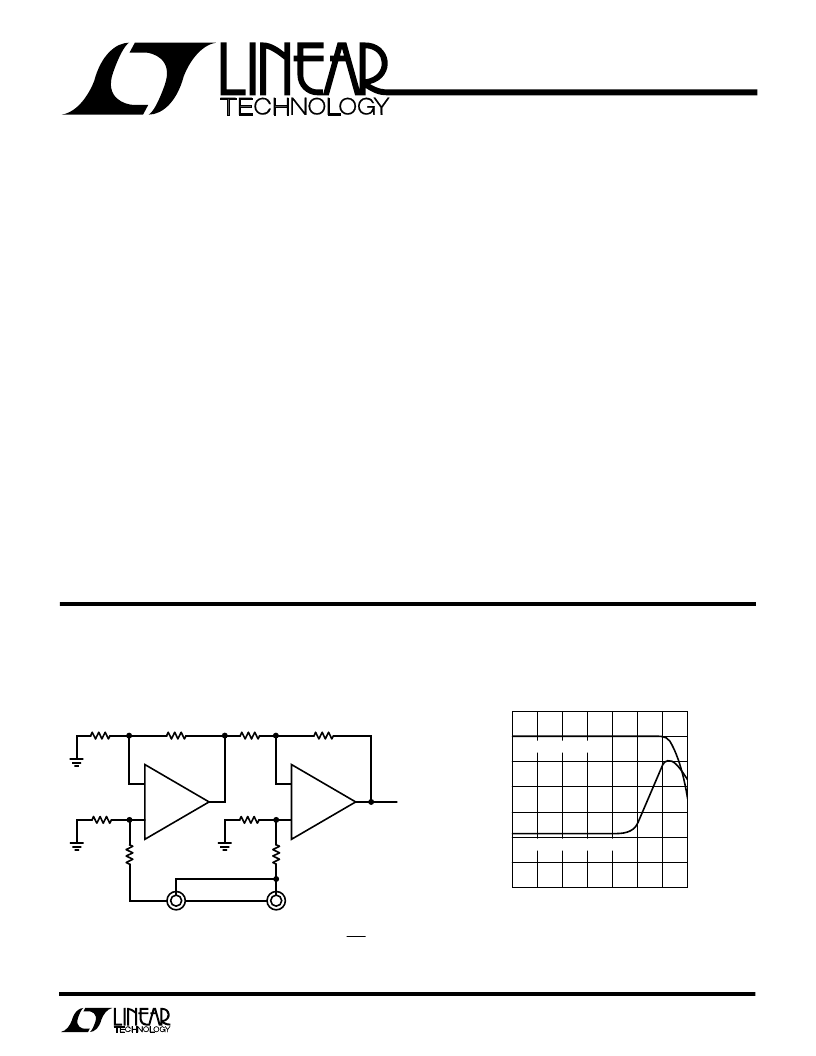- 您現(xiàn)在的位置:買賣IC網(wǎng) > PDF目錄377695 > LT1230MJ (LINEAR TECHNOLOGY CORP) CAP DRY FILM 8UF 210VAC STACKED PDF資料下載
參數(shù)資料
| 型號: | LT1230MJ |
| 廠商: | LINEAR TECHNOLOGY CORP |
| 元件分類: | 運動控制電子 |
| 英文描述: | CAP DRY FILM 8UF 210VAC STACKED |
| 中文描述: | QUAD OP-AMP, 15000 uV OFFSET-MAX, CDIP14 |
| 封裝: | 0.300 INCH, HERMETIC SEALED, CERDIP-14 |
| 文件頁數(shù): | 1/12頁 |
| 文件大小: | 292K |
| 代理商: | LT1230MJ |

1
LT1229/LT1230
Dual and Quad 100MHz
Current Feedback Amplifiers
D
U
ESCRIPTIO
S
FEATURE
The LT1229/LT1230 dual and quad 100MHz current feed-
back amplifiers are designed for maximum performance
in small packages. Using industry standard pinouts, the
dual is available in the 8-pin miniDIP and the 8-pin SO
package while the quad is in the 14-pin DIP and 14-pin SO.
The amplifiers are designed to operate on almost any
available supply voltage from 4V (
±
2V) to 30V (
±
15V).
These current feedback amplifiers have very high input
impedance and make excellent buffer amplifiers. They
maintain their wide bandwidth for almost all closed-loop
voltage gains. The amplifiers drive over 30mA of output
current and are optimized to drive low impedance loads,
such as cables, with excellent linearity at high frequencies.
The LT1229/LT1230 are manufactured on Linear
Technology’s proprietary complementary bipolar process.
For a single amplifier like these see the LT1227 and for
better DC accuracy see the LT1223.
I
100MHz Bandwidth
I
1000V/
μ
s Slew Rate
I
Low Cost
I
30mA Output Drive Current
I
0.04% Differential Gain
I
0.1
°
Differential Phase
I
High Input Impedance: 25M
, 3pF
I
Wide Supply Range:
±
2V to
±
15V
I
Low Supply Current: 6mA Per Amplifier
I
Inputs Common Mode to Within 1.5V of Supplies
I
Outputs Swing Within 0.8V of Supplies
U
S
A
O
PPLICATI
I
Video Instrumentation Amplifiers
I
Cable Drivers
I
RGB Amplifiers
I
Test Equipment Amplifiers
U
A
O
PPLICATI
TYPICAL
–
+
V
OUT
LT1229 TA01
12.1k
R
F2
750
1% RESISTORS
WORST CASE CMRR = 22dB
TYPICALLY = 38dB
V
OUT
= G (V
IN+
– V
IN–
)
R
F1
= R
F2
R
G1
= (G – 1) R
F2
R
G2
=
TRIM CMRR WITH R
G1
HIGH INPUT RESISTANCE DOES NOT LOAD CABLE EVEN
WHEN POWER IS OFF
L1/2
R
F2
G – 1
R
G2
187
R
F1
750
R
3.01k
–
+
L1/2
3.01k
3.01k
12.1k
V
IN–
V
IN+
BNC INPUTS
Video Loop Through Amplifier
Loop Through Amplifier Frequency
Response
FREQUENCY (Hz)
10
–60
G
–50
–40
–30
–20
–10
10
100
1k
10k
100M
LT1229 TA02
100k
1M
10M
0
COMMON-MODE SIGNAL
NORMAL SIGNAL
相關(guān)PDF資料 |
PDF描述 |
|---|---|
| LT1230C | Dual and Quad 100MHz Current Feedback Amplifiers |
| LT1230CN | Dual and Quad 100MHz Current Feedback Amplifiers |
| LT1230CS | Dual and Quad 100MHz Current Feedback Amplifiers |
| LT1230M | Dual and Quad 100MHz Current Feedback Amplifiers |
| LT1229CN8 | Dual and Quad 100MHz Current Feedback Amplifiers |
相關(guān)代理商/技術(shù)參數(shù) |
參數(shù)描述 |
|---|---|
| LT1230MJ/883 | 制造商:Linear Technology 功能描述:OP Amp Quad Current Fdbk ±15V 14-Pin CDIP |
| LT1231 | 制造商:未知廠家 制造商全稱:未知廠家 功能描述:Optoelectronic |
| LT1232 | 制造商:未知廠家 制造商全稱:未知廠家 功能描述:Optoelectronic |
| LT1236 | 制造商:LINER 制造商全稱:Linear Technology 功能描述:Ultra Precision Reference |
| LT1236-10 | 制造商:LINER 制造商全稱:Linear Technology 功能描述:Precision Reference |
發(fā)布緊急采購,3分鐘左右您將得到回復(fù)。